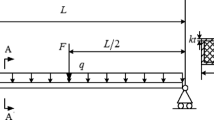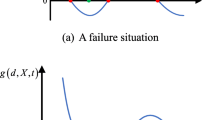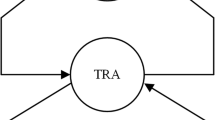Abstract
Time-variant reliability analysis (TRA) is widely utilized to assess the performance of engineering structures under various time-variant uncertainties. Recently, the time discretization-based TRA (TDTRA) methods have been developed, which can achieve satisfactory accuracy but need to excessively perform most probable point (MPP) searches at many equidistant time instants. To improve the efficiency of TDTRA, this paper proposes a TRA method based on approximating the MPP trajectory, referred to as AMPPT. First, this paper introduces a new concept of the MPP trajectory (MPPT), which is defined as the moving path of the MPP in the U-space when time changes. Then, a one-dimensional Kriging model is constructed to approximate the MPPT by the adaptive sampling method, which only performs MPP searches at several critical time instants. To further improve the computational efficiency, a warm-starting strategy is proposed to accelerate the MPP search. Then, the approximated MPPT is employed to transform the time-variant response into an equivalent Gaussian process. Finally, the spectral decomposition method and Monte Carlo simulation are used to compute the time-variant reliability. Comparative studies on four numerical examples and one practical engineering example of the solid rocket engine shell verify that the proposed AMPPT outperforms TDTRA in terms of both accuracy and efficiency. Test results also indicate that the efficiency gain of the proposed AMPPT comes from not only the reduction in the number of MPP searches but also the acceleration of the MPP search itself.




















Similar content being viewed by others
References
Andrieu-Renaud C, Sudret B, Lemaire M (2004) The PHI2 method: a way to compute time-variant reliability. Reliab Eng Syst Saf 84:75–86. https://doi.org/10.1016/j.ress.2003.10.005
Chen J-B, Li J (2007) The extreme value distribution and dynamic reliability analysis of nonlinear structures with uncertain parameters. Struct Saf 29:77–93. https://doi.org/10.1016/j.strusafe.2006.02.002
Choi KK, Youn BD (2004) An Enriched Performance Measure Approach (PMA+) for Reliability-Based Design Optimization Process. In: SAE 2004 World Congress & Exhibition, Detroit
Davydov YM, Egorov MY (2001) The instability of the working process in the combustion chamber of a solid-propellant rocket engine. Dokl Phys 46:195–198. https://doi.org/10.1134/1.1364728
Dormand JR, Prince PJ (1980) A family of embedded Runge-Kutta formulae. J Comput Appl Math 6:19–26. https://doi.org/10.1016/0771-050X(80)90013-3
Du X, Chen W (2001) A most probable point-based method for efficient uncertainty analysis. J Des Manuf Autom 4:47–66. https://doi.org/10.1080/15320370108500218
Eldred MS, Agarwal H, Perez VM et al (2007) Investigation of reliability method formulations in DAKOTA/UQ. Struct Infrastruct Eng 3:199–213. https://doi.org/10.1080/15732470500254618
Gano SE, Renaud JE, Martin JD, Simpson TW (2006) Update strategies for kriging models used in variable fidelity optimization. Struct Multidiscip Optim 32:287–298. https://doi.org/10.1007/s00158-006-0025-y
Giunta A, Watson L (1998) A comparison of approximation modeling techniques - polynomial versus interpolating models. In: 7th AIAA/USAF/NASA/ISSMO Symposium on Multidisciplinary Analysis and Optimization. American Institute of Aeronautics and Astronautics, Reston, Virigina
Gong C (2017) System reliability analyses and optimal maintenance planning of corroding pipelines. The University of Western Ontario
Gong C, Frangopol DM (2019) An efficient time-dependent reliability method. Struct Saf 81:101864. https://doi.org/10.1016/j.strusafe.2019.05.001
Gong C, Zhou W (2017) Improvement of equivalent component approach for reliability analyses of series systems. Struct Saf 68:65–72. https://doi.org/10.1016/j.strusafe.2017.06.001
Hawchar L, El Soueidy C-P, Schoefs F (2017) Principal component analysis and polynomial chaos expansion for time-variant reliability problems. Reliab Eng Syst Saf 167:406–416. https://doi.org/10.1016/j.ress.2017.06.024
Hawchar L, El Soueidy C-P, Schoefs F (2018) Global kriging surrogate modeling for general time-variant reliability-based design optimization problems. Struct Multidiscip Optim 58:955–968. https://doi.org/10.1007/s00158-018-1938-y
Hohenbichler M, Rackwitz R (1982) First-order concepts in system reliability. Struct Saf 1:177–188. https://doi.org/10.1016/0167-4730(82)90024-8
Hu Z, Du X (2012) Reliability analysis for hydrokinetic turbine blades. Renew Energy 48:251–262. https://doi.org/10.1016/j.renene.2012.05.002
Hu Z, Du X (2013a) A sampling approach to extreme value distribution for time-dependent reliability analysis. J Mech Des Trans ASME 135:1–8. https://doi.org/10.1115/1.4023925
Hu Z, Du X (2013b) Time-dependent reliability analysis with joint upcrossing rates. Struct Multidiscip Optim 48:893–907. https://doi.org/10.1007/s00158-013-0937-2
Hu Z, Du X (2015a) Mixed efficient global optimization for time-dependent reliability analysis. J Mech Des 137. https://doi.org/10.1115/1.4029520
Hu Z, Du X (2015b) First order reliability method for time-variant problems using series expansions. Struct Multidiscip Optim 51:1–21. https://doi.org/10.1007/s00158-014-1132-9
Jiang C, Huang XP, Han X, Zhang DQ (2014) A time-variant reliability analysis method based on stochastic process discretization. J Mech Des 136:91009. https://doi.org/10.1115/1.4027865
Jiang C, Huang XP, Wei XP, Liu NY (2017) A time-variant reliability analysis method for structural systems based on stochastic process discretization. Int J Mech Mater Des 13:173–193. https://doi.org/10.1007/s10999-015-9324-z
Jiang C, Wei XP, Wu B, Huang ZL (2018) An improved TRPD method for time-variant reliability analysis. Struct Multidiscip Optim 58:1935–1946. https://doi.org/10.1007/s00158-018-2002-7
Jiang C, Wang D, Qiu H et al (2019) An active failure-pursuing Kriging modeling method for time-dependent reliability analysis. Mech Syst Signal Process 129:112–129. https://doi.org/10.1016/j.ymssp.2019.04.034
Jiang C, Qiu H, Gao L et al (2020) Real-time estimation error-guided active learning Kriging method for time-dependent reliability analysis. Appl Math Model 77:82–98. https://doi.org/10.1016/j.apm.2019.06.035
Li J, Mourelatos ZP (2009) Time-dependent reliability estimation for dynamic problems using a niching genetic algorithm. J Mech Des 131. https://doi.org/10.1115/1.3149842
Li M, Wang Z (2017) Sequential Kriging optimization for time-variant reliability-based design involving stochastic processes. In: Volume 2A: 43rd Design Automation Conference. American Society of Mechanical Engineers
Li M, Wang Z (2018) Confidence-driven design optimization using Gaussian process metamodeling with insufficient data. J Mech Des 140:. https://doi.org/10.1115/1.4040985
Li M, Wang Z (2019) Surrogate model uncertainty quantification for reliability-based design optimization. Reliab Eng Syst Saf 192:106432. https://doi.org/10.1016/j.ress.2019.03.039
Li J, Chen J, Fan W (2007) The equivalent extreme-value event and evaluation of the structural system reliability. Struct Saf 29:112–131. https://doi.org/10.1016/j.strusafe.2006.03.002
Li M, Bai G, Wang Z (2018a) Time-variant reliability-based design optimization using sequential kriging modeling. Struct Multidiscip Optim 58:1051–1065. https://doi.org/10.1007/s00158-018-1951-1
Li X, Gong C, Gu L et al (2018b) A sequential surrogate method for reliability analysis based on radial basis function. Struct Saf 73:42–53. https://doi.org/10.1016/j.strusafe.2018.02.005
Li G, Yang H, Zhao G (2020) A new efficient decoupled reliability-based design optimization method with quantiles. Struct Multidiscip Optim 61:635–647. https://doi.org/10.1007/s00158-019-02384-7
Lim D, Jin Y, Ong YS, Sendhoff B (2010) Generalizing surrogate-assisted evolutionary computation. IEEE Trans Evol Comput 14:329–355. https://doi.org/10.1109/TEVC.2009.2027359
Liu P-L, Der Kiureghian A (1986) Multivariate distribution models with prescribed marginals and covariances. Probab Eng Mech 1:105–112. https://doi.org/10.1016/0266-8920(86)90033-0
Lophaven SN, Nielsen HB, Søndergaard J (2002) DACE-A MATLAB Kriging toolbox. Technical University of Denmark. Technical Report No. IMM-TR-2002-12.
Madsen HO, Krenk S, Lind NC (2006) Methods of structural safety. North Chelmsford, MA, USA
Paffrath M, Wever U (2007) Adapted polynomial chaos expansion for failure detection. J Comput Phys 226:263–281. https://doi.org/10.1016/j.jcp.2007.04.011
Parhi A, Mahesh V, Kalluru K et al (2018) Development of slow-burning solid rocket booster for RLV-TD hypersonic experiment. Current Science 114:74. https://doi.org/10.18520/cs/v114/i01/74-83
Rackwitz R, Flessler B (1978) Structural reliability under combined random load sequences. Comput Struct 9:489–494. https://doi.org/10.1016/0045-7949(78)90046-9
Rice SO (1944) Mathematical analysis of random noise. Bell Labs Tech J 24:46–156
Roussouly N, Petitjean F, Salaun M (2013) A new adaptive response surface method for reliability analysis. Probab Eng Mech 32:103–115. https://doi.org/10.1016/j.probengmech.2012.10.001
Schuëller GI (1997) A state-of-the-art report on computational stochastic mechanics. Probab Eng Mech 12:197–321. https://doi.org/10.1016/S0266-8920(97)00003-9
Shampine LF, Reichelt MW (1997) The MATLAB ODE suite. SIAM J Sci Comput 18:1–22. https://doi.org/10.1137/S1064827594276424
Sudret B (2008) Analytical derivation of the outcrossing rate in time-variant reliability problems. Struct Infrastruct Eng 4:353–362. https://doi.org/10.1080/15732470701270058
Sudret B, Der Kiureghian A (2002) Comparison of finite element reliability methods. Probab Eng Mech 17:337–348. https://doi.org/10.1016/S0266-8920(02)00031-0
Sun Z, Wang J, Li R, Tong C (2017) LIF: a new Kriging based learning function and its application to structural reliability analysis. Reliab Eng Syst Saf 157:152–165. https://doi.org/10.1016/j.ress.2016.09.003
Wang Z, Chen W (2016) Time-variant reliability assessment through equivalent stochastic process transformation. Reliab Eng Syst Saf 152:166–175. https://doi.org/10.1016/j.ress.2016.02.008
Wang Z, Wang P (2012) A nested extreme response surface approach for RBDO with time-dependent probabilistic constraints. In: Volume 3: 38th Design Automation Conference, Parts A and B. American Society of Mechanical Engineers, pp 735–744
Wang Z, Wang P (2013) A new approach for reliability analysis with time-variant performance characteristics. Reliab Eng Syst Saf 115:70–81. https://doi.org/10.1016/j.ress.2013.02.017
Zhang D, Han X, Jiang C et al (2017) Time-dependent reliability analysis through response surface method. J Mech Des 139. https://doi.org/10.1115/1.4035860
Funding
The present work was partially supported by the National Natural Science Foundation of China (grant no. 11502209), the National Defense Fundamental Research Funds of China (grant no. JCKY2016204B102, JCKY2016208C001).
Author information
Authors and Affiliations
Corresponding author
Ethics declarations
Conflict of interest
The authors declare that they have no conflict of interest.
Replication of results
The complete source code (written in MATLAB) of the four compared methods (including MCS, TDTRA, eSPT, and the proposed AMPPT), as well as the five test examples, is provided in the supplementary material, where
-
The folder “methods” contains four MATLAB files, “MCS.m,” “TDTRA.m,” “eSPT.m,” and “AMPPT.m,” which are the well-established source code of MCS, TDTRA, eSPT, and the proposed AMPPT, respectively.
-
The folder “tools” contains fundamental tools for the time-variant reliability analysis, including the functions for MPP-search, Nataf transformation, realization of random variables and stochastic processes, Kriging model, etc.
-
The folders from “model1” to “model5” contain the source code of the five test examples, respectively.
Additional information
Responsible Editor: Pingfeng Wang
Publisher’s note
Springer Nature remains neutral with regard to jurisdictional claims in published maps and institutional affiliations.
Electronic supplementary material
ESM 1
(RAR 290 kb)
Appendix. Kriging model
Appendix. Kriging model
Without loss of generality, the method for constructing the jth (j = 1, 2, …, n + m) component u^MPP, j(t) of the one-dimensional multioutput Kriging model u^MPP(t) is briefly described as follows.
The Kriging model (Lophaven et al. 2002; Li and Wang 2018, 2019) approximates an unknown function uMPP, j(t) as
where f(t) is a polynomial term of the input parameter t and s(t) is a Gaussian process with zero mean and covariance Cov[s(tp), s(tq)]. In this paper, the polynomial term f(t) is treated as a constant μ. The covariance Cov[s(tp), s(tq)] of s(t) is calculated by
where σ2 is the variance of s(t) and the R(tp, tq) is the correlation coefficient.
The Gaussian function is commonly used in R(tp, tq)
where θ is a parameter that can be determined by the maximum likelihood estimation (Giunta and Watson 1998).
Assume n time-MPP samples {(ti, u^MPP(ti))| i = 1, 2, …, n} are available for training u^MPP, j(t). Denote y = {uMPP, j(ti)| i = 1, 2, …, n}. The natural logarithm of the likelihood function is defined as
where R is a n × n correlation matrix defined by R = [R(tp, tq)]n × n and A is a n × 1 unit vector. By setting the derivatives of (45) with respect to μ and σ2 to zero, μ and σ2 can be estimated as
Substituting (46) into (45), the unknown parameter θ can be determined by maximizing the likelihood function
Once all hyper parameters are obtained, the Kriging model u^MPP, j(t) can be used to predict the jth (j = 1, 2, …, n + m) component of the MPP at an arbitrary time instant t′:
where r is a correlation vector defined by r = [R(t′, t1), R(t′, t2), …, R(t′, tn)]T. The variance of the prediction in (48) is given by
Rights and permissions
About this article
Cite this article
Zhang, Y., Gong, C. & Li, C. Efficient time-variant reliability analysis through approximating the most probable point trajectory. Struct Multidisc Optim 63, 289–309 (2021). https://doi.org/10.1007/s00158-020-02696-z
Received:
Revised:
Accepted:
Published:
Issue Date:
DOI: https://doi.org/10.1007/s00158-020-02696-z




